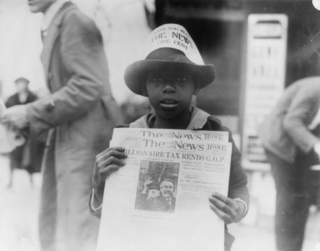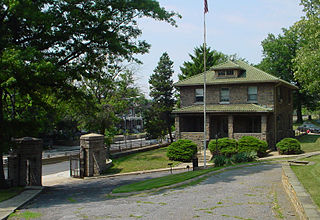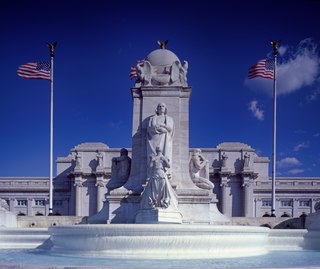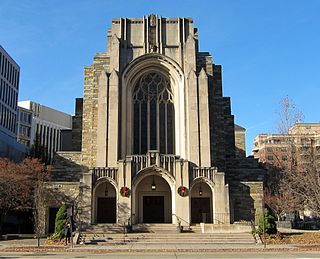
16th Street Northwest, briefly known as the Avenue of the Presidents, is a prominent north-south boulevard in Washington, D.C., located in Northwest D.C. The street was laid out as part of the 1791 L'Enfant Plan, which served as the original blueprint for the city. The street begins just north of the White House, across from Lafayette Square in the President's Park, and continues north along the Washington meridian until Blair Circle.

The Washington Daily News (1921-1972) was an afternoon tabloid-size newspaper serving the Washington, D.C., metropolitan area and published daily except Sundays.

Grant Circle is a traffic circle in the Petworth neighborhood of Northwest Washington, D.C. New Hampshire and Illinois Avenues NW, Varnum Street NW, and 5th Street NW all intersect at this circle. The park within the circle and the adjoining triangles is owned and administered by the National Park Service through its Rock Creek Park unit. The circle and the buildings flanking it were listed on the National Register of Historic Places in 2015.

Prospect Hill Cemetery, also known as the German Cemetery, is a historic German-American cemetery founded in 1858 and located at 2201 North Capitol Street in Washington, D.C. From 1886 to 1895, the Prospect Hill Cemetery board of directors battled a rival organization which illegally attempted to take title to the grounds and sell a portion of them as building lots. From 1886 to 1898, the cemetery also engaged in a struggle against the District of Columbia and the United States Congress, which wanted construct a main road through the center of the cemetery. This led to the passage of an Act of Congress, the declaration of a federal law to be unconstitutional, the passage of a second Act of Congress, a second major court battle, and the declaration by the courts that the city's eminent domain procedures were unconstitutional. North Capitol Street was built, and the cemetery compensated fairly for its property.

Universalist National Memorial Church (UNMC) is a Unitarian Universalist church located at 1810 16th Street, Northwest in the Dupont Circle vicinage of Washington, D.C. Theologically, the church describes itself as "both liberal Christian and Universalist". Originally a member of the Universalist Church of America, it became a member of the Unitarian Universalist Association (UUA) in 1961 when the former merged with the American Unitarian Association to form the UUA, and in 2003, UNMC strengthened its ties to the UUA.

Calvary Baptist Church is a Baptist church located in the Chinatown neighborhood in Washington, D.C. affiliated with the American Baptist Churches USA, the Cooperative Baptist Fellowship, the Baptist Peace Fellowship of North America, the Alliance of Baptists, the District of Columbia Baptist Convention, and the Association of Welcoming and Affirming Baptists.

Columbus Fountain also known as the Columbus Memorial is a public artwork by American sculptor Lorado Taft, located at Union Station in Washington, D.C., United States. A centerpiece of Columbus Circle, Columbus Fountain serves as a tribute to the explorer Christopher Columbus. The unveiling in 1912 was celebrated all over Washington, DC over the course of three days with parades, concerts and fireworks gathering tens of thousands of people from all over the world.

The First Baptist Church of the City of Washington, D.C. is a Baptist church at 1328 16th Street NW, Washington, D.C. First Baptist partners with the Alliance of Baptists, American Baptist Churches USA, Cooperative Baptist Fellowship, and the District of Columbia Baptist Convention.

P Street refers to four different streets within the city of Washington, D.C. The streets were named by President George Washington in 1791 as part of a general street naming program, in which east–west running streets were named alphabetically and north–south running streets numerically.

The Peter Muhlenberg Memorial is a public monument in Washington, D.C. It honors John Peter Gabriel Muhlenberg, a Lutheran minister, Continental Army general, Federalist Era American politician, and member of the prominent Muhlenberg family. The memorial is located in a one-acre park bounded by Connecticut Avenue, Ellicott Street, and 36th Street NW on the eastern edge of Washington's Wakefield neighborhood. Designed by architect John Harbeson, it features at its center a bronze bust of Muhlenberg, sculpted by his descendant, Caroline M. Hufford. Completed in 1980, 52 years after its construction was authorized by Congress, attendees at the dedication ceremony included West German ambassador Peter Hermes.

Samuel Harrison Greene was an American Baptist pastor, church leader, and university official.
The following is a timeline of the history of Lexington, Kentucky, United States.
Columbian Harmony Cemetery was an African-American cemetery that formerly existed at 9th Street NE and Rhode Island Avenue NE in Washington, D.C., in the United States. Constructed in 1859, it was the successor to the smaller Harmoneon Cemetery in downtown Washington. All graves in the cemetery were moved to National Harmony Memorial Park in Landover, Maryland, in 1959. The cemetery site was sold to developers, and a portion used for the Rhode Island Avenue – Brentwood Washington Metro station.

The Presbyterian Burying Ground, also known as the Old Presbyterian Burying Ground, was a historic cemetery which existed between 1802 and 1909 in the Georgetown neighborhood of Washington, D.C., in the United States. It was one of the most prominent cemeteries in the city until the 1860s. Burials there tapered significantly after Oak Hill Cemetery was founded nearby in 1848. The Presbyterian Burying Ground closed to new burials in 1887, and about 500 to 700 bodies were disinterred after 1891 when an attempt was made to demolish the cemetery and use the land for housing. The remaining graves fell into extensive disrepair. After a decade of effort, the District of Columbia purchased the cemetery in 1909 and built Volta Park there, leaving nearly 2,000 bodies buried at the site. Occasional human remains and tombstones have been discovered at the park since its construction. A number of figures important in the early history of Georgetown and Washington, D.C., military figures, politicians, merchants, and others were buried at Presbyterian Burying Ground.
Nathan Corwith Wyeth was an American architect. He is best known for designing the West Wing of the White House, creating the first Oval Office. He designed a large number of structures in Washington, D.C., including the Francis Scott Key Bridge over the Potomac River, the USS Maine Mast Memorial, the D.C. Armory, the Tidal Basin Inlet Bridge, many structures that comprise Judiciary Square, and numerous private homes—many of which now serve as embassies. He also co-designed the Cannon House Office Building, the Russell Senate Office Building, the Longworth House Office Building, and an addition to the Russell Senate Office Building.
The following is a timeline of the history of Washington, D.C., the capital city of the United States.
The following is a timeline of the history of the city of Augusta, Georgia, USA.

Sereno Edwards Bishop was a scientist, Presbyterian minister and publisher. He was an avid proponent of the United States annexation of the Hawaiian Islands, and aligned himself with the political faction who overthrew the monarchy under Liliuokalani.
Rev. Dr. Robert Simon Laws, a formerly enslaved person and Howard University graduate, founded two African American Baptist churches in the 19th century that have active congregations in the 21st century.

Mount Zion Baptist Church, established in 1866, is the oldest African American church in Arlington, Virginia. The church is a member of the National Baptist Convention USA and the Progressive National Baptist Convention.






















